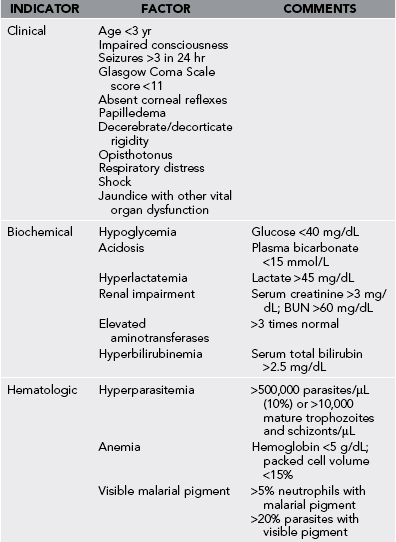Malaria
Malaria is a mosquito-transmitted, blood-borne, parasitic infection present throughout tropical and developing areas of the world. Parasites are transmitted by 30 to 40 (out of 430) species of the female Anopheles mosquito, which tends to bite between dusk and dawn. Estimated worldwide incidence is 500 to 800 million cases per year. Malaria infection causes a severe febrile illness that is potentially fatal, with most deaths occurring from Plasmodium falciparum infection in children in sub-Saharan Africa. Plasmodium sporozoites enter the bloodstream following inoculation from the mosquito and pass to the liver, where they develop into schizonts. Hepatic cells containing schizonts then rupture, releasing merozoites that then invade erythrocytes. These further develop into trophozoites or gametocytes within the erythrocyte. Free gametocytes invade the intestinal wall of feeding mosquitoes and develop into sporozoites, thus perpetuating the cycle of inoculation (Fig. 47-1). Pathologic presentations of malaria, such as fever and anemia, occur during the asexual phase of the parasitic infection, in which the malaria parasite invades the healthy erythrocytes (erythrocytic phase). Parasitic replication over the subsequent 2 to 3 days following initial infection of healthy erythrocytes is followed by cell rupture and subsequent exponential parasite reproduction.
Five species of malaria typically cause disease in humans:
1. Plasmodium vivax (worldwide distribution, but uncommon in sub-Saharan Africa)
2. P. falciparum (worldwide distribution, predominant in sub-Saharan Africa, Amazon basin, Haiti, limited in Asia and Oceania)
3. Plasmodium ovale (West Africa, Amazon basin)
Clinical Manifestations and Complications (Table 47-1)
1. Clinical manifestations first evident 1 to 2 weeks after entry into endemic area (sooner if infected blood obtained through transfusion or shared needles)
2. No pathognomonic signs, but common symptoms (Table 47-2)
Table 47-2
Common Symptoms and Their Incidence in Malaria
| SYMPTOM | INCIDENCE (%) |
| Fever | 97 |
| Chills | 97 |
| Headaches | 94 |
| Nausea/vomiting | 62 |
| Abdominal pain | 56 |
| Myalgia | 50 |
| Backache | 9 |
| Dark urine | 3 |
3. Paroxysms of chills followed by high fever and sweating
a. May last several hours and occur every 2 to 3 days
b. Classic periodic attacks often not observed in severe P. falciparum malaria; fever possibly constant
5. Cerebral malaria (associated with high levels of P. falciparum parasitemia), characterized by high fevers, confusion, seizures, and eventually coma and death
6. Acute renal failure, pulmonary edema
7. Definitive diagnosis only by the presence of parasite-containing red blood cells (detected on thick and thin blood smears [see Plate 33])
8. Clinical attacks during the first 4 to 8 weeks after return from the area of exposure
9. Prolonged latent incubation times (up to 3 years) reported
10. Complications are more common with P. falciparum infection than with other species of malaria.
11. Factors indicating a poor prognosis for persons with severe malaria include clinical, biochemical, and hematologic features (Table 47-3).








